Teaching
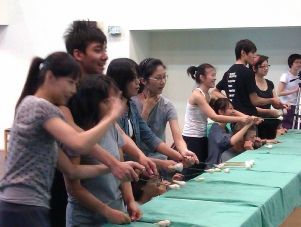 Stephen's teaching work started when he was asked to devise puppet manipulation exercises for a group of professional dancers at the Oswald Andrade Cultural Centre in Sao Paulo, Brazil. These exercises led to a series of movement workshops entitled "Consciously Manipulative". He has taught two courses in movement at the San Martin Puppet Theatre School, Buenos Aires, Argentina, and in movement and animation at Hanoi Youth Theatre, Vietnam. He has led workshops across Europe and also in Chile, Equador, Indonesia and Taiwan and taught at Holborn Centre for the Performing Arts, Central School of Speech and Drama, E15 School of Acting, Institut International de la Marionnette and Maaf Academia di Figura. His current movement workshops are called "The Logic of Movement"
Stephen's teaching work started when he was asked to devise puppet manipulation exercises for a group of professional dancers at the Oswald Andrade Cultural Centre in Sao Paulo, Brazil. These exercises led to a series of movement workshops entitled "Consciously Manipulative". He has taught two courses in movement at the San Martin Puppet Theatre School, Buenos Aires, Argentina, and in movement and animation at Hanoi Youth Theatre, Vietnam. He has led workshops across Europe and also in Chile, Equador, Indonesia and Taiwan and taught at Holborn Centre for the Performing Arts, Central School of Speech and Drama, E15 School of Acting, Institut International de la Marionnette and Maaf Academia di Figura. His current movement workshops are called "The Logic of Movement"
The Logic of Movement
A workshop about why things move in the way they do, and how knowing about this helps the puppeteer and other stage practitioners to express ideas more successfully to an audience.
The elements which lie behind our vocabulary of movement are quite easy to identify - responses to gravity, the need to move from place to place, tension patterns and changes in movement tempo linked to emotions like fear or pleasure. Similarly we all continually read movement information in the world around us. We judge the speed of cars on the road; know when someone is happy or sad; recognise in the distance our friends and relatives simply by the way they walk.
Our ability to read this movement information lies deep in our animal past. Natural selection has favoured creatures with good survival strategies and knowing what the movement in the world around us means, has been a vital element in the survival of most creatures. As a result, we humans decode movement information with a mind boggling degree of sophistication.
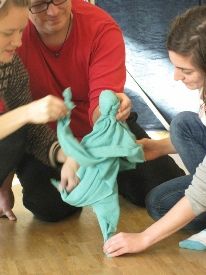 However, almost always in puppet theatre, where moving things about is so obviously a large part of what is being offered to the audience, movement itself is given little conscious attention and at best is assumed to be produced by the intuitive ability of the puppeteer. Often this lack of attention to movement as a principal means of communication leaves performances far short of their potential. This workshop sets out to bring movement back to the forefront of the puppeteer's art.
However, almost always in puppet theatre, where moving things about is so obviously a large part of what is being offered to the audience, movement itself is given little conscious attention and at best is assumed to be produced by the intuitive ability of the puppeteer. Often this lack of attention to movement as a principal means of communication leaves performances far short of their potential. This workshop sets out to bring movement back to the forefront of the puppeteer's art.
The aim is to develop a conscious movement technique and increase awareness of how puppet movement is perceived by an audience.
The duration of the Logic of Movement workshop is flexible. A lot can be achieved in a single day, but the normal length is between two days and a week.
Marionettes - Design and Construction
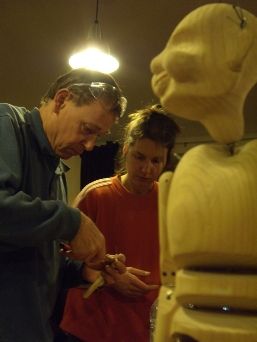 During this nine/ten day course we look at the way movement qualities which are quintessentially human, can be built into the marionette to give it the potential for shockingly realistic human movement.
During this nine/ten day course we look at the way movement qualities which are quintessentially human, can be built into the marionette to give it the potential for shockingly realistic human movement.
Whilst we spend a part of the time looking at the logic and meaning of human movement, the main emphasis is on constructing and learning about marionettes. We study design issues and historical precedents in the construction of string puppets and each participant makes a modern, performable marionette for themselves.
We work primarily in wood, and although experience of cutting and shaping wood is an advantage, the course is still suitable for people with little experience of working in the medium.
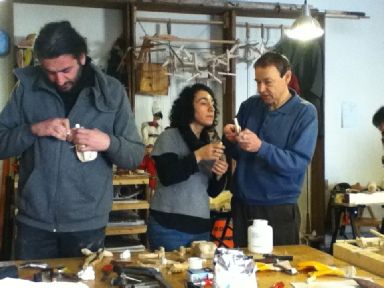 This workshop can only take place in a venue equipped with woodworking benches and a minimum of standard tools such as saws, a pillar drill and a disc sander.
This workshop can only take place in a venue equipped with woodworking benches and a minimum of standard tools such as saws, a pillar drill and a disc sander.
There is also a short list of tools such as a small saw, a knife for carving, a gouge and chisel, pliers, etc which participants will be expected to bring with them.
The workshop is a practical answer to the question: "where can I get a good marionette which really works?"
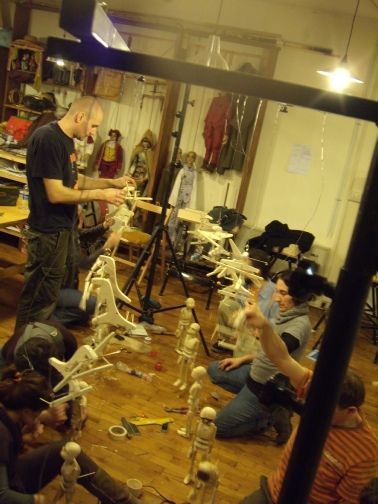
For more information on booking a workshop please contact Stephen .

